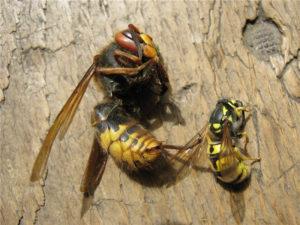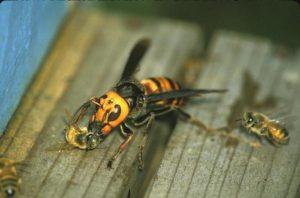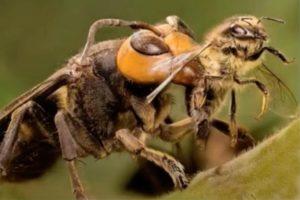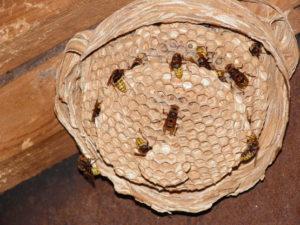Who is an ordinary hornet: acquaintance with a large striped wasp
One of the most interesting wasp species is the hornet. This is the largest species in this family. The second name of insects is winged pirates.
Content
Common hornet: photo
Description of the hornet
Name: Hornet
Latin: VespaClass: Insects - Insecta
Squad: Hymenoptera - Hymenoptera
family: Real wasps - Vespidae
 | Habitats: | everywhere |
 | Features: | large size, sting |
 | Benefit or harm: | fights insect pests, eats fruits, destroys bees |
The hornet is the largest wasp that lives in Europe. The size of the working individual is from 18 to 24 mm, the size of the uterus is from 25 to 35 mm. Visually, female and male individuals are very similar. Although there are differences.
The male has 13 segments on the mustache and 7 on the belly. The female has 12 on the mustache and 6 on the abdomen. The wings are transparent and small. They are located along the back at rest. The eyes are reddish-orange with a deep "C" slit. There are thick hairs on the body.
Predators sting and tear their prey with their jaws. The content of the poison is 2 times greater than that of an ordinary wasp. The bite causes severe pain and swelling that persists for several days. These insects can be found in dense forest.
Habitat
There are 23 types of insects. Initially, only East Asia was the place of residence. However, thanks to people, they even conquered North America and Canada, despite the fact that they are typical inhabitants of the subtropics.
The common hornet inhabits Europe, North America, Kazakhstan, Ukraine. In the Russian Federation, they can be found up to the border with Europe. An insect also lives in the northern and eastern provinces of China.
It is worth noting that this type of wasp was accidentally brought to North America by European sailors only in the middle of the 19th century.
Difference from a wasp

Hornet and wasp.
Large dimensions and an enlarged nape distinguish this species. They also have a different color. The back, belly, antennae of the hornets are brown, and those of the wasp are black. Otherwise, they have an identical body structure, a thin waist, a sting, and a strong jaw.
The nature of the insects is also different. Large hornets are not as aggressive as wasps. They start attacking when approaching their nest. Strong fear in people is caused by impressive size and a formidable buzzing.
Life cycle
An entire generation of the giant wasp comes from a single queen.
In the spring, she looks for a place to start building for the new generation. The queen produces the first honeycombs herself. Later, the queen lays eggs in them. After a few days, larvae appear that need animal food.
The female catches caterpillars, beetles, butterflies, and other insects to feed her offspring. The grown larva excretes and becomes a pupa. After 14 days, the young individual gnaws through the cocoon.
In the middle of summer, working females and males grow up. They complete the honeycombs, bring protein to the larvae. The uterus no longer leaves the home and lays eggs.
Life expectancy is short. Insects grow by the end of summer, but in September a significant part dies. Surviving individuals can stretch until the first cold weather.
September is the peak of the population. The queen lays her eggs during her last laying. Females emerge from them, which subsequently become new queens.
Previous individuals are obtained with modified ovaries. Their functions are suppressed by the queen's pheromones. Juveniles swarm around the hive and mate. Sperm obtained in the fall is stored to create a new generation. After mating, the male can live up to 7 days. The old mother is being kicked out.
Hornets wintering
Most of them die before winter. Fertilized females survive young. By hunting, they replenish the energy reserve. Daylight hours decrease and diapause occurs. In this state, there is a delay in metabolic processes in the body.
They can overwinter in secluded places. They hide from the cold and their enemies. The females are under the bark of trees. Great depth gives a high probability of survival. They can also live in hollow trees, crevices in a barn and attic.
Females wake up in May at a temperature of at least 10 degrees Celsius.
Diet
Giant wasps are omnivorous insects. They are good at hunting. However, they also love plant foods. Their diet consists of:
- nectar;
- juice of soft peach, pear, apple;
- berries - raspberries, blackberries, strawberries;
- aphid secretions.
Insects tend to eat their larvae. Worker hornets feed their offspring with spiders, centipedes, and worms. Powerful jaws tear prey and feed protein to the queen and larvae. The uterus needs it to lay eggs.
Insects can eliminate an entire hive of bees. The hornet destroys about 30 honey plants. Predatory varieties eat 500 g of pests.
Life
It is not recommended to make sudden movements and shake the nest. Also, do not kill hornets near the hive, as a dying individual transmits an alarm signal and encourages an attack.
Building a nest
To create a nest, hornets choose a secluded place that is protected from drafts. Insects are excellent architects. They are able to create unique homes.
In construction, birch or ash wood is used. It is wetted with saliva. The surface of the nest is similar to cardboard or corrugated paper. The design expands downward. There are about 500 cells in honeycombs. The color of the cocoon is affected by the wood. Most often it has a brown color.
Hornet bite
Bite causes a painful and allergic condition. The consequences are influenced by the type of insect and individual intolerance to the poison. The first signs of a bite are redness, swelling, pain, high fever, and impaired coordination.
With such symptoms, a cold lotion is applied and an antihistamine is taken. Sometimes symptoms appear after a while. It is necessary to monitor the state of health and the site of the bite.
Conclusion
Hornets play a huge role in nature. They destroy pest populations. However, they are able to damage fruits, plunder apiaries, eat bees and honey. Destruction of nests is not safe for humans. Without a clear reason, you should not eliminate the hive.
Previous


